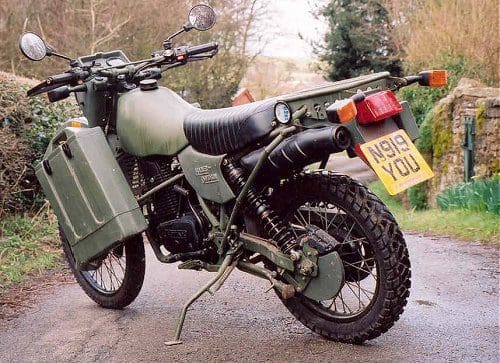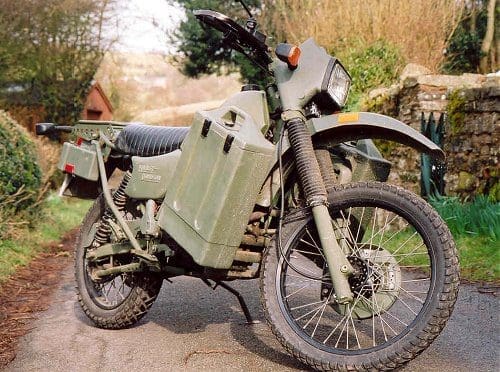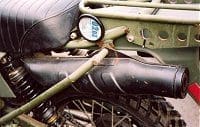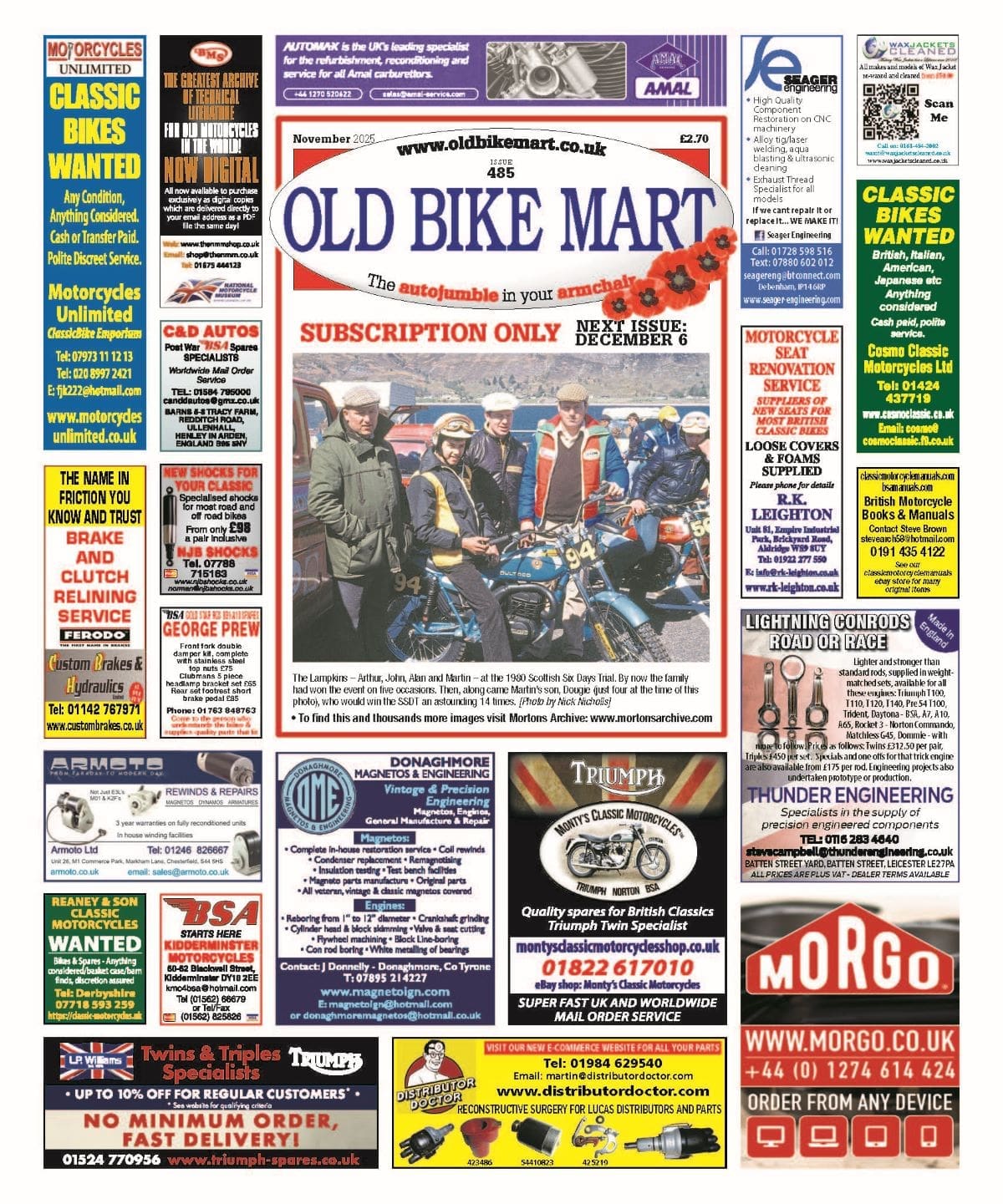By popular demand (well, OK, one person) we reveal the pros and cons of buying an ex-Army trailie-bike. Rowena Hoseason actually spent her own money on some old military surplus scrap…
Army surplus. What does that make you think of? Sweaty socks, fresh from squaddies’ feet? Dodgy Land Rovers which have been carelessly lobbed out of aeroplanes a few dozen times? All those stalls at bike shows which sell suspiciously new-looking surplus gear in cool camo colours? Mmm. Me too.
Enjoy more classic motorcycle reading, Click here to subscribe to one of our leading magazines.

See, I could never work out how something was supposed to be ‘government surplus’. I mean, either a pair of socks is knackered — so why would anyone buy them — or a pair of socks is perfectly wearable — so why would anyone chuck them out and sell them cheap? The same applies to Land Rovers and camo jackets. Oh, and motorbikes, of course.
So for years I’ve wandered past the occasional ex-Army bikes that I’ve seen for sale, assuming that there must be something deeply and fundamentally wrong with them, and have steered a wide path around them with a vague feeling of regret. Regret? Well, they’re bloody stonking, ain’t they? Not those horrid old 2-stroke phut-phut stinkwheels, no, I mean the Rotax-engined 4-stroke trailbikes done out in matt drab with knobbly tyres and gun carriers and vast panniers and industrial-strength luggage racks and strangely inexplicable lengths of scaffold pole brazed all abouts. THOSE ex-Army bikes. Phwoar, as you might have overheard me say. Lara Croft’s Landie? Pah.
The last couple of winters have been so appallingly ghastly, however, that I was convinced to take another look. Even our A65 scrambled (flatteringly described by that nice Mr Minton as an ISDT-rep) is too nice to take out around here in winter. From November through to, well, about mid-July I think, the lanes are awash with slime and mud and salt and slurry. I wouldn’t want to take anything with a hint of chrome anywhere near these roads — not and expect it to maintain structural integrity until the summer. So a real rufty-tufty trailbike was called for, and I gave some serious thought to the odd-looking Army bikes.
This is where I did something which we always tell people who ask advice that they should never, ever do. I just made my mind up that the Army bike looked like fun and started the buying process. That’s about the worst thing you can do: by the time I actually sat on one I had already convinced myself that it was the only bike in the world for me and I would never be happy without it. You should never, ever do this — unless of course you’re happy to trade your mistakes onto some other mug in six months time!
So I got to snouting around the internet. Turns out that the bikes I’d been hanging my nose over were really Harley-Davidsons — just like it said on the sidepanel. I’d never quite believed it before. These aren’t your made-in-Italy kind of H-Ds either; these are real, genuine, born in the USA Pennsylvanian-built Harley-Davidson 350s (but H-D tend to keep quiet about them). Yet anyone who has bothered to look a little closely at the bikes will know that they’re extremely similar to the previous Army machines, the Armstrong MT500s. And with an oil-in-frame chassis and a Rotax engine, the MT350 also has a lot in common with the bikes currently made by CCM. What gives?
It seems that Harley bought the rights to manufacture the MT-series machines from the UK concern, Armstrong (who do indeed have something to do with CCM), when NATO chose the MT as its standard steed. The Americans didn’t want to be riding around on anything foreign, bless ’em, so they bought up the option to make the bikes themselves. The MT500 was considered to be too powerful for modern Army duties — or perhaps it was just too much for the Americans to handle? — so it was downsized to a 350. To give them their dues, Harley also overhauled and upgraded much of the Armstrong’s ancillaries, correcting some flaws in the design and equipping the bike with an electric start. So now it’s known as the MT350E, and you won’t get a hot bot any more as Harley moved the reg-rec heat-sink from under the seat to somewhere more sensible, in the open air.
OK, now I want you to forget that I’m talking about an Army bike at all. Forget that it says ‘Harley Davidson’ on the tank. Just imagine that I’m talking about a pre-65-type mud-plugger. What would you think if I told you; 30bhp, 160kg, 80mph top end, 50mpg, 255mm ground clearance. Oh, and disc brakes. You would have to be a little impressed, wouldn’t you? Especially if you considered that you could dump kilos and boost the ground clearance by losing a pannier or gun carrier or two. Oops; gave the game away. Gun carrier! How can anyone resist?

The MT350E’s looks, specification and capabilities got me seriously interested. I loved my old BMW F650, but it was a porky old plugger. The saddle was wide and comfy, which also made it harder to sling around in mud. The Honda AX-1 grey import trailster I borrowed a few years back was ideal, much lighter and slimmer, just the job. And indeed, the MT350E isn’t altogether a different kettle of carp from the AX-1. I would use the B25 of course… but we all know that one is anchored to the inside of the Shed so firmly that an earthquake couldn’t shake it. And I only once asked FW if his G15CS was up for serious use — the cat was traumatised for days by his response.
This definitely sounds like a mind being made up!
Now all I had to do was find one of these ex-Army wonders, which required a little detective work. If you go to the bigger classic events in the Midlands then you may well have seen these bikes being sold by an Army surplus trader. They turned out to be LMS Ltd of Lichfield, and motorbikes are but a tiny part of their repertoire. Basically, LMS wholesale Army surplus anything; clothing, equipment, jeeps, bikes, boats — didn’t see a battleship in their yard but you never know what was under the tarpaulins! LMS are happy to sell to the public, too, but that’s exactly what they do: sell. They’re not a showroom or a retailer so there’s no scope for family day-out tyre-kicking. But once I explained that I had folding in my pocket and wasn’t going to muck them around for hours, Chris and Diane were more than happy enough to arrange an RV. (that’s rendezvous, not Recreational Vehicle. Get with the lingo, dude!).
At shows, LMS usually have two or three newish bikes on display. Not unreasonably, I was expecting them to have maybe a dozen back at the ranch. So an array of about 20 of the little rattlers, all showing miniscule mileage, knocked me back a bit — and then I discovered that this was only the tip of the bikeberg. ‘We’ve got hundreds more at the warehouse,’ grinned Chris. Huh?
This is where my complete misunderstanding about Army surplus came to the fore. How could hundreds of low-mileage, virtually unused bikes be effectively thrown away by the military? The answer is that the forces simply have to buy more on a regular basis. Why? Because you can’t expect your supplier (of spoons, boots or motorbikes) to suddenly be able to produce hundreds of thousands of items at the drop of a treaty, should your armed forces need to leap into action. The tooling, skills and manpower for all these complicated bits of equipment can’t be kept on ice during peacetime. To maintain military readiness, you have to keep the manufacturers busy. To do that, you have to turn over your equipment — spoons, boots and motorbikes — at regular intervals, be they worn out or not. Hence government surplus. Hence Harley-Davidson MT350E motorcycles, with under 2000km on the clock, being sold for around £2000. Yipe!
OK; there are drawbacks to this. Some cretin in khaki could have done his utter worst to your chosen bike and how would you know? And even if it’s been scrupulously maintained, then you still have to reckon with the bike’s lack of use. The ones I looked at were all from 1995-96 vintage and had done tiny miles since then. There are things to examine which will verify that mileage — metal footrests get rounded off with use, cables fray and have to be replaced, levers get worn and shiny, plastic panels get scuffed, and wheel rims show marks when tyres have been frequently changed. Avoid any machine which has all of those tell-tales yet claims to be ‘very low mileage.’
The engine is the main component which, on any used bike, you have to fret and bother over. This Rotax air-cooled lump is bullet-proof (ahem) even when thrashed senseless by the military. You need to check that it’s not been taken apart and reassembled by some semi-evolved simian (or trainee engineers); look for chewed up fasteners, gunge instead of gaskets, or odd oil weeps. You also need to use your ears. I tried two different MTs and both fired up immediately, on the button, with the aid of a fully charged battery. The motor sounds a lot like the one out of my old F650, except louder. Well it would be — the Beemer big-bore version of this engine is liquid-cooled! But there were no rattles or clatter, just a steady whirr once the motor had warmed through and was sitting at tick-over. Sweet.

The bikes I looked at had smooth-moving forks, and the tall rear suspension bounced without juddering or sticking. They really hadn’t moved much in six years — but that still didn’t make the immune to the effects of aging. Buy one of these bikes and you are taking a machine which has been laid up for all of its life, with occasional excursions to prove that it still functions within operational parameters. In the real world this means that it may be home to Mr Corrosion; the engine won’t have been run in properly (or at all), and the various lubricating and hydraulic fluids will be as much use as toothpaste.
These bikes need a careful going over before you buy (just in case they really have been thrown out of an aeroplane during manoeuvres!), and re-commissioning before you ride.
On an MT, recommissioning involves replacing the engine’s timing belt — if it’s been in one position for a long time then it will have ‘set’ and gone rigid — changing or cleaning the air and oil filters, lubing the cables, maybe changing the drive chain — it will have developed tight spots just like the belt — and if you’re doing that then you might as well do the sprockets, too. New fork oil and seals never go amiss, ditto brake pads.
Oh, and mine needed an MoT and registering too.
You can avoid all this agro, however, by buying a demobbed MT from a dealer. Church Stretton Motorcycles, for instance, can get these bikes, and they do all the preparation, road registering and faffing around for you. CSMC are 45 minutes ride from Birmingham, on 01694 723546. You will have to pay more for an MT from them than LMS will charge you — but if you buy direct from a wholesaler then you are faced with a huge choice of unprepared bikes, and they are sold strictly as seen and ‘for restoration.’
Mind you, although I was pretty wary of it, registering my Snarley was not a trial. (Snarley? Well, it can’t be a Hawg now can it?). The MT came with an Army discharge certificate — without which the job would have been nigh-on impossible. You also need an insurance certificate, which your broker can issue using the bike’s chassis number as its identifying mark (Footman James got me a new certificate within 24 hours which impressed the hell out of me!). You need an MoT — again, it’ll use the bike’s frame number. And then you need to tromp along to your local VED office, pay them £25, and fill in only a few boxes on a very complicated form. It really wasn’t hard — even a gurl could do it, as TP would say.
Righto: little Snarley set to go. Road-ready and revved up to rumble. Just one minor, teensy-weensy little problemette. When I rode the Snarley around the yard at LMS and figured ‘Yup, that’ll do’ it hadn’t been re-commissioned. Perhaps one of the most vital things you need to do with a bike that’s been stood for three years is… to put air in its tyres. I slung a leg over the Snarley saddle and was amazed to find that my tootsies didn’t get anywhere near the ground on the other side. Adding air to the tyres had boosted the bike’s height by two inches!
It’s just as well I don’t get vertigo…
Next Inciting Extallment: Snarley gets grubby! What the Harley-Davidson MT350E is like to ride. Bet you can’t wait, eh?


